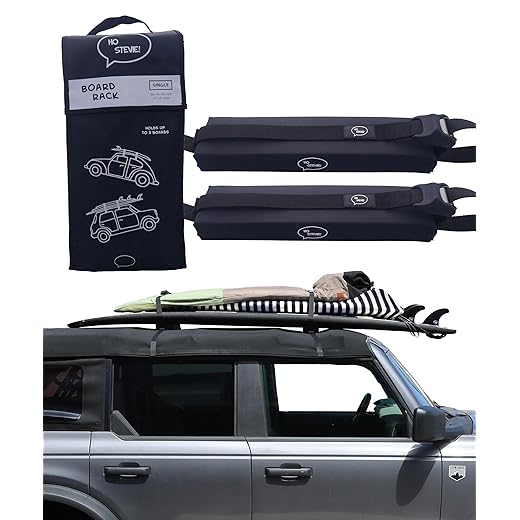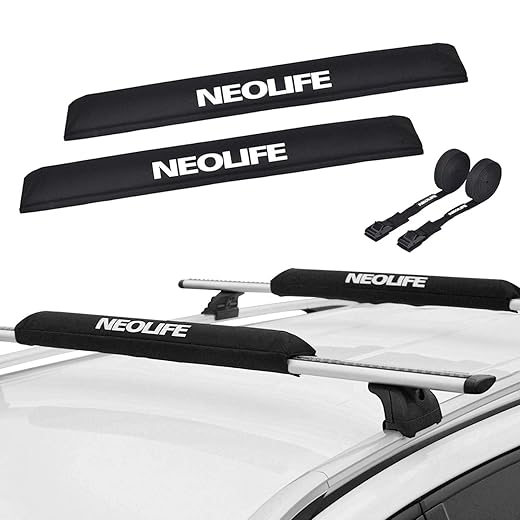As a passionate surfer, I understand the thrill of heading to the beach with my board in tow, but the last thing I want is to worry about whether my surfboard is secure during the journey. If you’ve ever found yourself asking, “Can I use a standard roof rack for my surfboard?” you’re not alone. Many surfers grapple with this question, as the right setup can make a significant difference in both convenience and safety. In this blog post, I’ll dive into the compatibility of standard roof racks with surfboards, address common concerns, and share valuable tips to ensure your board reaches the waves safely and securely. Let’s explore how to make the most of your roof rack experience!



Understanding Roof Racks
When it comes to transporting outdoor sports equipment like surfboards, understanding the various types of roof racks available can greatly enhance your experience. Not all roof racks are created equal, and selecting the right one for your needs can make all the difference in ensuring the safety and stability of your gear while driving. In this section, we will explore the different types of roof racks, the materials used, weight capacities, and attachment methods, helping you choose the best option for transporting surfboards.
Types of Roof Racks
There are two primary types of roof racks: factory-installed racks and aftermarket options. Each type has its own advantages and characteristics that suit different lifestyles and vehicle types.
Factory-Installed Roof Racks
Factory-installed roof racks come pre-equipped on many vehicles. They’re designed specifically for a particular make and model, ensuring a reliable fit and ease of use. These racks typically integrate seamlessly with your vehicle’s design, reducing wind noise and improving aerodynamics.
Examples:
- Subaru Outback: Known for its robust factory roof rack that accommodates multiple accessories without the need for additional installation.
- Toyota RAV4: Comes with crossbars designed to handle a variety of attachments, including surfboard carriers.
Pros:
- Perfect fit for your vehicle.
- Lower installation time and cost.
- Often designed to maintain vehicle aesthetics.
Cons:
- Limited capacity when compared to aftermarket racks.
- Might not support all types of accessories.
Aftermarket Roof Racks
Aftermarket roof racks are third-party solutions that offer greater versatility in terms of types and configurations. These racks can be installed on a wider range of vehicles and often come with additional features that cater to specific needs.
Popular Examples:
- Thule AeroBlade Edge: Offers a quiet ride and is designed for maximum aerodynamic efficiency. Suitable for transporting surfboards when used with compatible surfboard carriers.
- Yakima JetStream: Known for its lightweight yet strong aluminum construction, this rack is enhanced for easy installation and removal.
Pros:
- Greater variety of models and styles tailored for different activities.
- Higher load capacity options available.
- Flexibility in terms of attachments and accessories.
Cons:
- May require professional installation, depending on the complexity.
- Initial cost can be higher than factory options.
Materials Used in Roof Racks
The materials used in the construction of roof racks play a significant role in their durability, weight capacity, and performance. Understanding these materials can help you determine which option is right for transporting surfboards.
- Aluminum: Lightweight and resistant to corrosion, aluminum racks are popular for their strength without adding significant weight to the vehicle. Both Thule and Yakima make aluminum roof racks that are especially favorable for surfboard transport.
- Steel: Known for its robust strength, steel racks usually have higher weight capacities. However, these racks tend to be heavier and may be more susceptible to rust if not professionally coated.
Weight Capacity Considerations
When choosing a roof rack for surfboards, the weight capacity is paramount. Roof racks are rated for varying weights, and it’s crucial to stay within these limits to ensure vehicle safety.
Weight Capacity Examples:
| Brand | Model | Weight Capacity | Ideal Use |
|---|---|---|---|
| Thule | AeroBlade Edge | 220 lbs | Surfboards, kayaks, etc. |
| Yakima | JetStream | 165 lbs | Surfboards, bikes, etc. |
| Rhino-Rack | Vortex | 220 lbs | Surfboards, roof boxes |
Attachment Methods
The way a roof rack attaches to your vehicle can affect both its performance and the ease of loading and unloading your surfboards. The most common attachment methods include:
- Factory Tracks: These are often built into the roof of the vehicle (like in many SUVs) and allow for a seamless fit with minimal wind resistance. Factory racks typically offer a clean look and are very stable.
- Clamps: Aftermarket racks usually use clamps to attach to the vehicle’s door frames or the roof. While they’re versatile and can fit most vehicles, improper installation can lead to instability, making it critical to follow manufacturer instructions carefully.
- Foot Packs: Some roof racks utilize foot packs that are designed to distribute weight evenly across the roof. This method is popular among brands like Thule and Yakima, allowing for easy installation and removal options depending on your needs.
Practical Considerations for Surfboard Transport
When selecting a roof rack specifically for surfboards, consider the following practical points:
- Padding and Protection: Look for racks that include padding or have options available to prevent damage to your surfboards during transit. Brands like FCS offer surfboard pads specifically designed to complement roof racks.
- Ease of Use: Some racks are designed for quick attachments, which can make loading and unloading your surfboard a breeze. Check the user-friendly features like adjustable arms or quick-release mechanisms.
By understanding the different types of roof racks, materials used, weight capacities, and attachment methods, you can make a well-informed decision that suits both your vehicle and surfboarding needs.
Understanding Surfboard Compatibility with Roof Racks
When it comes to transporting your surfboard, ensuring compatibility with roof racks is essential for a safe and secure journey. Various dimensions and characteristics of surfboards can significantly affect how well they fit onto standard roof racks. In this section, we will delve into the critical factors influencing surfboard compatibility, including board length, width, and fin configuration. Additionally, we will discuss the importance of using padding or protective covers to prevent any potential damage during transit.
Board Dimensions: Length and Width
Length Considerations
The length of your surfboard is one of the primary factors affecting its compatibility with roof racks. Most standard roof racks can accommodate boards ranging from 6 to 10 feet in length. However, it’s vital to check the specifications of your roof rack system. For instance:
- Thule SUP Taxi XT: This rack is designed to carry up to two boards measuring up to 10 feet long. It features a robust design equipped to handle various board shapes.
- Yakima SUPPaddle: This model can support boards up to 12 feet long, making it suitable for longer paddleboards as well.
Always ensure your surfboard does not extend excessively beyond the limits of your rack, as this can lead to dangerous overhangs and increased wind resistance.
Width Considerations
The width of the surfboard also plays a crucial role in roof rack compatibility. Most racks can comfortably handle boards with widths under 26 inches. Longer boards or those with wider profiles may require specially designed pads or straps to secure them firmly.
Key Points to Remember About Width:
- Standard width for longboards typically ranges between 22 to 24 inches.
- Fish-style boards may be narrower, generally around 19 to 21 inches.
A good example for wide boards is the Thule Board Shuttle, which comes with adjustable settings to accommodate boards of varying widths, ensuring a snug fit.
Fin Configuration
Another key factor influencing surfboard compatibility is the fin configuration. Surfboards often come with different fin setups such as single, thruster (three fins), or quad (four fins). Depending on the design of your roof rack, certain fin types may pose challenges during transport.
- Single Fin: Easier to transport as it doesn’t protrude much from the board.
- Thruster Fin: Generally fits well in standard racks, but be sure to remove the fins if your rack placement is proceeding without enough clearance.
- Quad Fin: Can be tricky as some racks may not provide ample space for the rear fins to fit beneath protective straps or pads.
Recommended Products:
For those using quad fin boards, the SportRack Jetty roof rack is a versatile option that offers added space and secure harnessing, ensuring no fin is damaged during transport.
Protective Padding and Covers
To prevent damage during transport, using padding or protective covers is highly recommended. This soft material not only acts as a buffer against road vibrations but also helps protect against scratches and dents.
- Thule Surfboard Pads: A great choice to wrap around your surfboards, providing cushioning and added grip for a secure fit.
- Dakine Paddle Board Bag: Ideal for those transporting paddleboards or wider surfboards, offering structured protection and a convenient carrying handle.
Benefits of Protective Padding:
- Reduces friction between the board and rack.
- Protects against UV damage while on the road.
- Provides additional stability, reducing the chance of board movement during transit.
Summary of Key Compatibility Factors
Here’s a quick reference summarizing the essential points to consider when assessing surfboard compatibility with roof racks:
| Factor | Considerations |
|---|---|
| Board Length | Ranges 6 to 10 feet; check specific rack limits. |
| Board Width | Typically ≤ 26 inches; ensure rack compatibility. |
| Fin Configuration | Single – easy; Thruster – standard; Quad – potential challenges. |
| Protective Padding | Essential to prevent damage and secure fit. |
By understanding these various dimensions and characteristics of your surfboard, you can select the appropriate roof rack and transport your gear safely and securely.
Final Thoughts on Roof Rack Compatibility for Surfboards
In conclusion, using a standard roof rack for your surfboard is feasible but requires careful consideration of your board’s size and the necessary safety precautions. To ensure the best protection and transport for your surfboard, I recommend assessing your individual requirements and exploring specialized equipment, especially if you frequently find yourself on the waves. Taking these factors into account will help you make an informed decision and enhance your overall surfing experience.
I’d love to know more about how to secure the surfboard on a roof rack. Any tips on straps or anything specific I should look for?
Thanks for your question! I can definitely dive deeper into securing surfboards with roof racks in a future post. Generally, using padded straps and making sure they’re snug is key, but I’ll provide more detailed tips soon!
Hey! Great article! Do you have any other resources or articles you recommend for someone new to using roof racks? I’m trying to get my setup just right!
One thing I worry about is the wind drag when driving with a surfboard on the roof. Anyone had issues with that? Seems like it could affect gas mileage too.
Great point! Wind drag is definitely a consideration. It can affect fuel efficiency, especially at higher speeds. I’ll make sure to include some tips on how to minimize drag in a follow-up article!